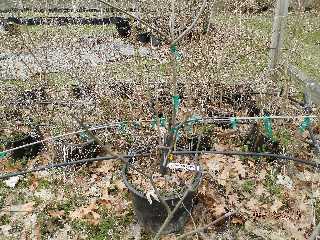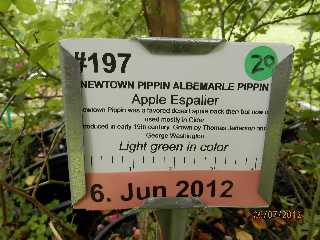

Espalier trained plants (pictures of) being trained for our Retail Plant Sale at the flowering shrub farm in Voorheesville, NY. We train fruit trees and crabapple trees for sale to Belgian Fence, Step-over and Horizontal-T. Pictures of the espalier trained trees we sell directly below here and below that is how we train espalier so scroll down. Picture on right shows quantity available for sale in a 7 gallon pot for $30 on green dot. No colored dot? None for sale. Click for larger image. yellow dot is 15 gallon for $50. If the pictures below dont open click espalier. Most of the changes to this page are made in September so check back then. Last edited 07/10/2011.
Dwarf 'Newtown Pippin' Apple Stepover or Horizontal T The quantity available for sale is expressed in the upper right hand side of the sign. If on a green dot they are in 7 gallon pots for $30 each, yellow dot $50 each. I over write these pictures frequently so you might want to reload the page to ensure your computer doesn't have it cached.
'Snowdrift' Flowering Crab Apple Belgian Fence
112 Stayman Winesap being trained to stepover and horizontal t
217 Bartlet Pear being trained to stepover and horizontal t
219 Liberty Apple tree being trained to stepover and horizontal t
220 Arkansas Black apple tree being trained to stepover and horizontal T
221 Donald Wyman crab apple tree being trained to belgian fence

The espalier is a restrictive form of fruit tree training (though it has been applied to many other types of plants) where trees or vines are tied and pruned so that the plant has a central stem that supports a number of paired branches that are trained in a single plane by tieing onto a trellis. Most people are more familiar to espalier as it is used in a vinyard to train grape vines.

In the above picture The stem on the left has been lowered to the horizontal, having already grown to around three feet long (in the horizontal position the leader wont lengthen as quickly while fruit spur production is increased). The stem on the right is a foot shorter and has been trained to a slightly more vertical position so it will grow a bit longer before being lowered as well. In the center I am training another stem up to the top wire for horizontal T.
A standard tree, may overshadow four hundred square feet of orchard. When replaced with 25 horizontal T espalier trained trees, six feet apart on 6 paralel trellises that are twenty five feet long and six feet apart (that uses the same square feet of space), each trees fruit is thinned to twenty fruit and you have five hundred fruit each larger than those on the standard because they have twenty five seperate root systems.
The leaves and stems of espalier trained trees and vines are easier to examine for damaging insects and preventative sprays are easier to apply. Traps for insects can be hung from the trellis and how bad the infestation is can be determined by counting how many insects were caught.
The big advantage, when training to espalier, of using dwarfing root stocks is not to reduce the size of the tree but to slow its growth, reduce required pruning and reduce the time between initial training and fruit production. Much of the time a standard needs is in the development of the stem needed to support all those fruit. An espalier because its on a trellis has an immediate support in the posts and wires.
The added advantage of being able to train many different fruit together (apples, pears, plums, peaches, apricots, blackberries, raspberries etc.) in a small area no doubt has added to espaliers popularity.
By running trellises from North to South the trees receive the maximum light possible during summer when the sun travels from east to west. In winter, when the sun is in the south each tree over shadows the one to its immediate north providing maximum protection from sunscald. In more southerly climates like the one that prevails in the mediteranean, trees can be trained onto a south facing wall or hillside where added sunlight later in the year will extend the growing season but in a climate where temperatures drop below freezing, warming the stem on a sunny wall during the day so the sap starts to run, then having temperatures drop again to below freezing at night, can cause sun scald damaging the stem and reducing its ability to produce fruit.

Tying belgian fence to the trellis.

The PVC clamped on top of the post keeps the posts from falling toward each other or away while allowing me to water the entire line of espalier from small sprayers attached every few feet. By attaching nearer one side of each post it is also easy to tie onto. When the spray hits the bamboo canes it trickles down and drips into each pot.

A Climbing Rose or Fruit tree trained to trellis fits the small garden much better than a standard shrub or tree. As I am training these plants to be sold, they are in pots, and because their roots cant be allowed to freeze in winter, the pots have to be surrounded with mulch in winter. So I use a raised bed, with three rows of pots surrounded by mulch. In the center row are plants being trained onto the wires (3 foot tall posts, every 6 feet, wires 15 inches apart, a 1 inch diameter watering line attached to the top of the posts). The outer rows have plants that can be removed easily when I need to tie branches to the trellis. Because I want to be able to slip these pots back into the mulch easily I use another empty pot (socket pot) to keep the hole open and slip the potted plant in and out as needed. This is called the pot-in-pot method of growing.
When training we always start by pruning back to just above the bottom wire and training the paired branches into a V and a center branch up to the second wire (spring of planting). Some trees are reluctant to form a center stem and so we train them to belgian fence or lower the arms to form a step over. Pruning the V back to twelve inches and lowering the arms slightly starts a fan. If the stepover still has a healthy center stem we train it to the second wire and the resulting paired branches finally lowered and tied to the top wire (usually in fall of the second year) creates a Horizontal T. After the structural training is over I am always training fruit spurs by cutting back branches that dont fit the design to 3 leaves at first then 2 leaves. I will go into more detail in other pages linked here as I create the pictures.
Click on the picture for a larger image. The snow covered flagstone path behind the belgian fence (00103belgianfence015_010310.jpg). In summer the belgian fence provides a tight hedge that has flowers in spring and fruit in fall.
Same belgian fence from an angle to better reveal the path between the garage and the trees (00103belgianfence007_010310.jpg). I try to start at least three new crops each year. This next year it will be 100 apple trees to espalier, 200 Pinxterbloom Azalea (R. nudiflorum) for threesomes in 3 gallon pots, 150 Lillacs ('President Poincaire',) in 3 gallon pots. After potting each crop I'll photograph it for the newsletter while finding a place where it can be watered, fertilized and photographed easily. FROM JANUARY NEWSLETTER .
The first part of training a belgian fence is training an unbranched maiden to a Y shape (00103belgianfence001_010310.jpg). This belgian fence composed of 'Liberty' and 'Nova Easygrow' apple trees was trained by me in the early 1990's. Next spring we should be receiving 50 'Stayman Winesap' and 50 'Liberty' Apple trees to train to espalier. FROM JANUARY NEWSLETTER .
Belgian Fence (01206belgianfence120609.jpg) FROM DECEMBER NEWSLETTER
The belgian fence next door (00009belgianfence091809) FROM SEPTEMBER NEWSNETTER
BELOW ARE PICTURES TAKEN previously

(00131belgianfence013100.jpg). FROM JANUARY NEWSLETTER
andyvancleve flowers.yonatan.us